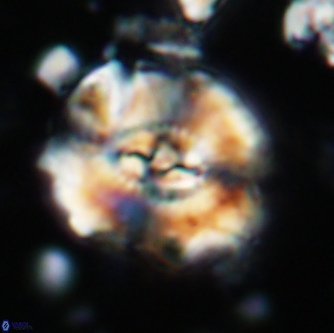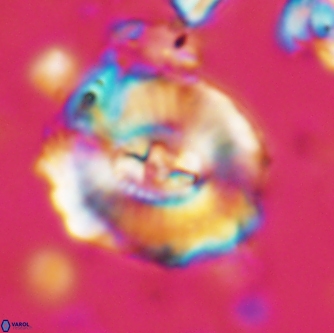Ellipsagelosphaera clausa
Set number: 1753
-
1
-
2
-
3
-
4
10µm
Holotype
Set number: 1754
-
1
-
2
-
3
-
4
10µm
Set number: 1755
-
1
-
2
-
3
-
4
10µm
Ellipsagelosphaera clausa Varol & Bowman, 2019
2009 Ellipsagelosphaera manivitiae/britannica – Giraud et al., fig. 4.24, 4.25.
2010 Watznaueria britannica, large (Stradner, 1963) Reinhardt, 1964. – Casellato, pl.2, fig. 2.
Large (> 10.00 μm) and elliptical species of Ellipsagelosphaera with a narrow central area filled by a traverse bar.
From Latin clausa, closed, referring to its closed central area by a traverse bar.
Length = 10.84 μm; width = 9.81 μm; length (central area) = 2.17 μm; width (central area) 1.73 μm.
Ellipsagelosphaera clausa is a large, elliptical species with a small central area cloaked by a traverse bar. It produces a first-order yellow interference colour in XPL. The bar consists of two short segments diverging away from each other as they meet the inner tube cycle. Each segment is further divided into two equal limbs at the middle. The adjacent limbs of the segments act optically differently, whereas the diagonal limbs of the segments appear optically similar. The central structure appears like a low-angle cross because of the diverging segments and similar optical properties of the diagonal limbs (Fig. 4 in Varol & Bowman, 2019).
Ellipsagelosphaera clausa is easily distinguished from other species of Ellipsagelosphaera by its large size, its yellow interference colour and small central area cloaked by a transverse bar.
Casellato, C. E. 2010. Calcareous nannofossil biostratigraphy of Upper Callovian-Lower Berriasian successions from the Southern Alps, North Italy. Riv. Ital. Paleontol. Stratigr., 116: 357–404.
Gale, A. S., Kennedy, W. J., Burnett, J. A., Caron, M. & Kidd, B. E. 1996. The Late Albian to Early Cenomanian succession at Mont Risou, near Rosans (Drôme, SE France): an integrated study (ammonites, inoceramids, planktonic foraminifera, nannofossils, oxygen and carbon isotopes). Cretac. Res., 17: 515–606.
Giraud, F., Courtinat, B. & Atrops, F. 2009. Spatial distribution patterns of calcareous nannofossils across the Callovian–Oxfordian transition in the French Subalpine Basin. – Mar. Micropaleontol., 72: 129–145.
Reinhardt, P. 1964. Einige Kalkflagellaten-Gattungen (Coccolithophoriden, Coccolithineen) aus dem Mesozoikum Deutschlands. - Monatsberichteder Deutschen Akademieder Wissenschaftenzu Berlin. 6: 749-759.
Stradner, H. 1963. New contributions to Mesozoic stratigraphy by means of nannofossils. Proceedings of the Sixth World Petroleum Congress. Section 1 Paper 4: 167-183.
Varol, O. & Bowman, A.R. 2019. Taxonomic revision of selected Late Jurassic (Tithonian) calcareous nannofossils and the application of mobile mounting. Neues Jahrbuch für Geologie und Paläontologie, Abhandlungen. 291/1 (2019): 1–23

